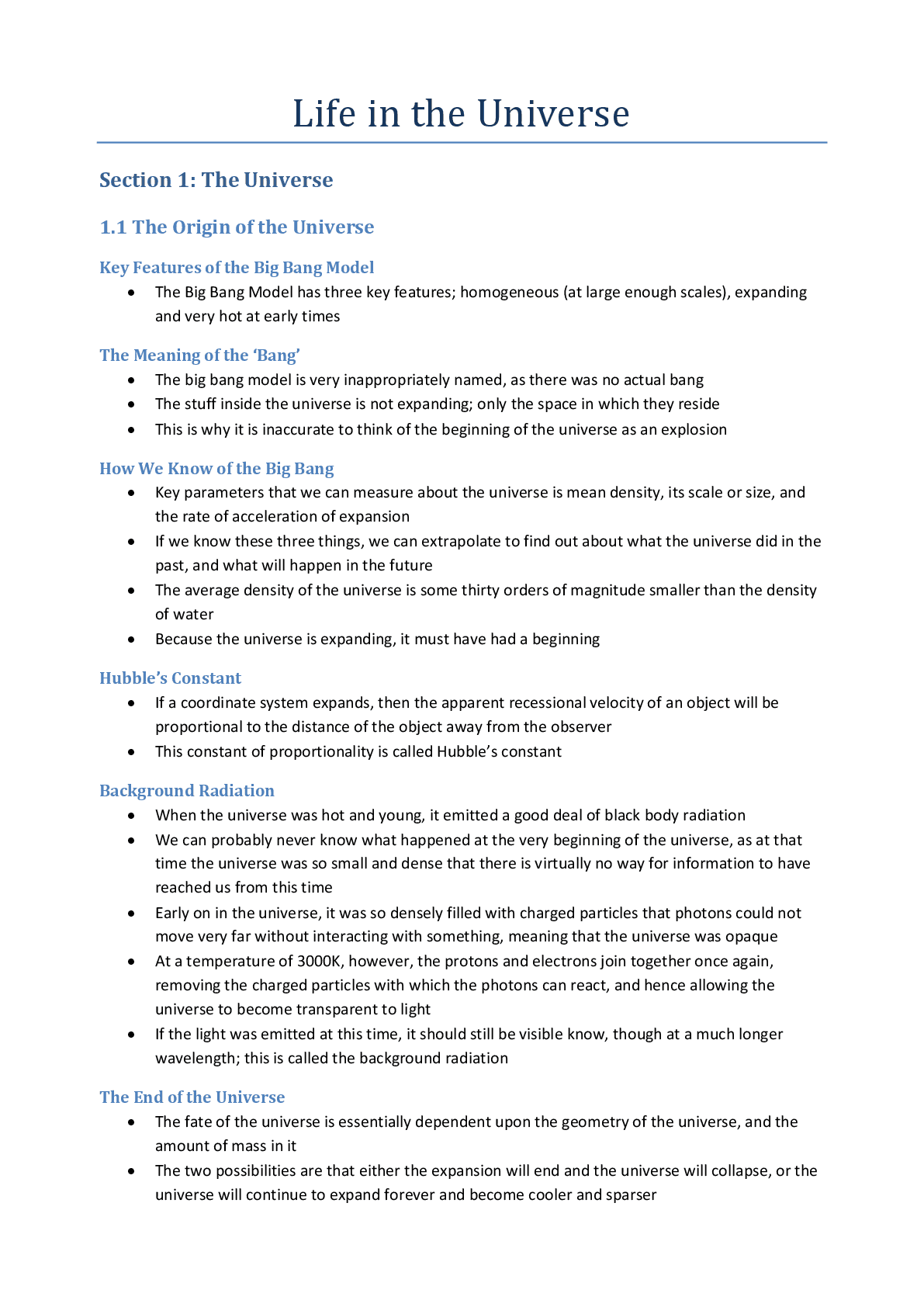

















































Study with the several resources on Docsity

Earn points by helping other students or get them with a premium plan


Prepare for your exams
Study with the several resources on Docsity

Earn points to download
Earn points by helping other students or get them with a premium plan
Community
Ask the community for help and clear up your study doubts
Discover the best universities in your country according to Docsity users
Free resources
Download our free guides on studying techniques, anxiety management strategies, and thesis advice from Docsity tutors
Life in the Universe for study
Typology: Study notes
1 / 55

This page cannot be seen from the preview
Don't miss anything!
















































Key Features of the Big Bang Model The Big Bang Model has three key features; homogeneous (at large enough scales), expanding and very hot at early times
The Meaning of the ‘Bang’ The big bang model is very inappropriately named, as there was no actual bang The stuff inside the universe is not expanding; only the space in which they reside This is why it is inaccurate to think of the beginning of the universe as an explosion
How We Know of the Big Bang Key parameters that we can measure about the universe is mean density, its scale or size, and the rate of acceleration of expansion If we know these three things, we can extrapolate to find out about what the universe did in the past, and what will happen in the future The average density of the universe is some thirty orders of magnitude smaller than the density of water Because the universe is expanding, it must have had a beginning
Hubble’s Constant If a coordinate system expands, then the apparent recessional velocity of an object will be proportional to the distance of the object away from the observer This constant of proportionality is called Hubble’s constant
Background Radiation When the universe was hot and young, it emitted a good deal of black body radiation We can probably never know what happened at the very beginning of the universe, as at that time the universe was so small and dense that there is virtually no way for information to have reached us from this time Early on in the universe, it was so densely filled with charged particles that photons could not move very far without interacting with something, meaning that the universe was opaque At a temperature of 3000K, however, the protons and electrons join together once again, removing the charged particles with which the photons can react, and hence allowing the universe to become transparent to light If the light was emitted at this time, it should still be visible know, though at a much longer wavelength; this is called the background radiation
The End of the Universe The fate of the universe is essentially dependent upon the geometry of the universe, and the amount of mass in it The two possibilities are that either the expansion will end and the universe will collapse, or the universe will continue to expand forever and become cooler and sparser
Our Galaxy The local group of galaxies has two large galaxies (Andromeda and the Milky Way), and about 35 other smaller galaxies (they are still being discovered)
Why Stars Formed The universe began as a very smooth (but not totally smooth) distribution of dark and baryonic matter As the universe evolved, regions of higher density slowly (and then increasingly more rapidly over time) collapsed under their own gravity
Forming stars The process begins as a cloud of gas collapses under its own weight This initial cloud will be composed only of hydrogen and helium, unless there has been contamination by supernovae Once the temperature and pressure at the centre of the gas cloud reaches high enough levels, nuclear fusion is ignited The peak emission of our sun sits at around 6000K, which corresponds to a colour of yellow This probably explains why our eyes are sensitive to light of around this wavelength
Low Mass Star Deaths The manner of death of a star is dependent only upon its mass Low mass stars burn all their hydrogen fuel, dorm white dwarf stars, and emit planetary nebula No planetary nebula is exactly alike, and all are different colours based upon the emission lines present
High Mass Star Deaths High mass stars burn all their hydrogen, and then progressively burn all their heavier elements until they get to iron At this point, the fusion process no longer produces energy. With no more heat generated, the star collapsed catastrophically, at an extremely rapid rate At a certain point, the material bounces back, blowing off most of the outer material of the star into space – this is a supernova Supernovae shine about as brightly as billions of stars, so they outshine whole galaxies and are visible during the day The remaining super-heavy core can either be a neutron star or a black hole Supernovae spew put the heavier elements that form the basis of all planets and such objects; there is no other known natural process can do this
What is light? Light can sometimes be considered a particle, and sometimes a wave Light is made of discrete entities called photons, each of which has a characteristic wavelength and energy
The process of planetary formation was not perfectly efficient, as there are many leftover bits of junk in the solar system, including asteroids (composition similar to rocky planets), and comets (composition similar to jovian planets)
The Beginning: Giant Molecular Cloud The Solar system formed from the gravitational collapse of a giant molecular cloud 4.6 billion years ago The term molecular refers to the fact that these were relatively heavy elements, and that they were relatively cool, as otherwise the molecules would have broken apart The cloud was enriched with elements that can only be formed in the supernova explosions of massive stars
Collapse Giant molecular clouds are usually fairly stable, and so generally are only triggered to collapse by some external catalyst In this case, it was probably the shockwave of a nearby supernova explosion, which compressed the cloud and began the collapse Hence, the rotating disk of dust began to collapse under gravity
Contraction The cloud formed a disk, which increased its spin and heated up Most of material collects at the centre, which became a star when temperatures are high enough
Formation of Planetesimals The outer parts of the disc cool before the inner parts of the disc, as they are less dense Difference compounds will condense out in a particular sequence, owing to different freezing points Solid particles slowly accumulate together in biffer and bigger clumps, eventually forming asteroid-sized bodies called planetesimals
Formation of Planets At this stage, the planetesimals are large enough to begin attracting each other by gravity, so the rate of accumulation increases We have done extensive computer simulations of this, and find that collapse occurs fairly quickly We would expect this process to produce roughly equally spaced planets, as otherwise the planets would attract each other and collide This process of planetary formation ends when the star ignites, as the solar wind would blow any smaller particles not attached to larger objects away
Leftover junk Because the accretion process was not perfectly efficient, there was lots of leftover junk in the solar system We would expect the junk to match the composition of the planets that are in that region Ice cannot exist in the inner solar system, so most of the material is rocky and metallic Beyond Neptune the matter was not dense enough to form any large planets
Observations about the Planets All giant planets have moon system like miniature solar systems The inner terrestrial planets are composed of mostly silicates and metals The other jovian planets are larger and have the same composition of the sun
Terrestrial planets Have hard surfaces All but Mercury have an atmosphere Composed mostly of rocks and metals, especially iron Are comparable in size to earth Are the four planets located closest to the sun Have few moons
Comparative Planetary Layers The outer layer of the mantle (at least on earth) is plastic, thereby allowing continental drift All the terrestrial planets, including the moon, have inner solid metal cores surrounded by mantle The earth, however, is the only one that has a liquid outer core Heavier materials inside a planet always sink to the core, while lighter materials rise to the top (these are called scum) Mantel rocks are rich in iron and magnesium, while crust rocks are rich in silicate, which is lighter
Mercury Covered with craters like the moon The same side of Mercury faces the sun most of the time, and so is very hot We know little about this planet, as it is not very interesting
Venus Similar to Earth, but with seventy times as massive an atmosphere Venus still has its original atmosphere The atmosphere is about 98% carbon dioxide, which has caused a runaway greenhouse effect The atmosphere is also covered by clouds of hydrosophic acid
Mars Most hospitable of the terrestrial planets for life It is possible that there may still be some life living under the surface of Mars There is definitely frozen water under the surface of Mars The surface features of Mars tell us that at one stage there was flowing liquid water on the planet, at the time when Mars had a thicker atmosphere owing to the greenhouse effect
Jovian Planets Composed mostly of hydrogen and helium, as well as a few metals If all these gases were removed, Jupiter would be about the same size as the earth
Stony: these are like terrestrial rocks, and may be difficult to distinguish unless the fall is witnessed (comprise about 93% of meteorites) Iron: there are nearly pure nickel-iron and have a high density (about 6% of meteorites) Stony-iron: a mixture of stone and iron (these comprise about 1% of meteorites) The iron meteorites are very similar in composition to the earth’s metallic core The stony meteorites are similar in composition to the mantle The stony irons are identified with a much smaller region, on the interface of the core and the mantle, hence explaining their rarity
How do Planets Eject Meteorites? One way that the metallic material from the centre of a planet can be released is by the oblique collision of a large planetary body with another, a collision which would spew out large amounts of metal Meteorites provide us with samples of the solar nebula, and insights into the formation of the planets and collapse of the solar nebula
Primitive and Carbonaceous Meteorites Primitive meteorites are those that date to the origin of the solar system, whereas differentiated meteorites date from some time later, during the period of planetary formation (they have been altered from this original form) Carbonaceous meteorites contain carbon and other organic material from the early days of the solar system, potentially the building blocks of life, as these types of rocks continually bombarded the earth during its early period Interplanetary dust particles are minute pieces of dust that rain down on earth as it orbits the sun, remnants of the original solar nebula
What are Chondrules? Chondrules are circular crystals found in some stony meteorites, which are essentially blobs of silicate that supercooled in zero gravity, hence forming circular glass blobs
Mars and the Moon Runny lava makes flat lava plains (e.g. Maria, or black smooth splodges, on the moon) The age of the basalt plains on the moon ranges from three to four billion years old Thicker lava makes broad shield volcanoes (e.g. Olympus Mons on Mars) The reason Olympus Mons is so big is because the crust of Mars does not move around as it does on earth, so the volcano is able to build up more and more material at the same place Thickest lava makes steep stratovolcanoes (e.g. Mount Hood on Earth)
Cryovolcanism on Europa Europa experiences cryovolcanism, with eruptions of carbon dioxide onto the surface ice The ridges and lines on the surface of europa are probably also caused by compression and expansion of the moon We expect that Europa has a rocky mantle covered by a layer of liquid water, with ice covering on the top
Arachnoid Formations on Venus Some meteorite impacts on Venus seem to have triggered volcanic eruptions
Arachnoid formations on Venus are created as a result of tectonic fractures made by the upwelling of huge amounts of magma Venus is covered with volcanoes, in fact about 80% of its surface
Other Cases of Volcanism Io has numerous sulphur volcanoes, owing to the periodic compression and expansion of the moon caused by the tidal forces of Jupiter Triton has plumes of liquid nitrogen erupting on the surface of the planet
Comparative Planetary Surfaces The surfaces of the moon and mercury are covered in craters, and look very similar Mars can be distinguished by its characteristic red colour, and also the trenches and riverbeds that cover the surface Venus is yellowish-green, and lacks impact craters, as most meteorites are melted and burned up in the thick atmosphere
Four Main Processes Volcanism: eruption of molten material onto the surface Meteorite impacts Tectonism: movement of tectonic plates Sedimentation and erosion
Continental Drift and Tectonics The middle ridges in the oceans are higher than surrounding regions because the rock that forms there is hot, and so is rising and is bigger An alternative theory of plate tectonics that existed in the 1960s was the Earth Expanding hypothesis, which explained the spread of the continents as being caused by the expansion of the earth
Why Earthquakes happen in Australia Earthquakes in Australia occur because the pacific plate is crashing into our plate around New Zealand, while the top of our plate is crashing into New Guinea The result is significant compression stress forces on our plate, which causes it to deform and buckle in the middle
Tectonic Activity in the Solar System Tectonic activity on Mercury and the moon ended about one billion years after the formation of the solar system Mars was active until it least 500 million years ago, and may well still be active today Venus was active until very recently, and once again may still be active
Weathering and Erosion Rounded boulders are created by the weathering of angular bounders, often by collision with many smaller boulders Angular boulders must be close to their source, while rounded boulders could have been moved a long way
In the past, the moon was about twenty times as close to the earth as it is now, which means that tidal forces would have been much greater This process will stop when the orbital period of the moon and the rate of rotation of the earth will be the same, about 55 days
The Moon and the Evolution of Life The moon stabilises the rotation of the earth’s axis, thereby stabilising the climate, making it easier for life to evolve Tidal forces from the moon created tidal pools, which are nutrient rich regions over which the tides move twice every day These are very good places for forming life
No Life in the Solar System By now it is fairly clear that there is no intelligent life anywhere else in the solar system, although the fact of microbial life is less clear The channels over the surface of Mars were first observed in 1870, and proposed that they were constructed by intelligent beings This idea formed the basis of HG Wells story ‘War of the Worlds’ By 1909, however, better telescopes had shown that the canals were not constructed, but merely natural phenomenon
Recipe for a Home for Life Requirement for heavy elements, such as oxygen, carbon, nitrogen and silicon A protective shield around a planet or other body, such as an atmosphere or liquid This would be necessary to protect against cosmic radiation and asteroid impacts Also need an energy source, probably a star Will require some kind of liquid, probably water A liquid or solid surface for life to develop on Most of these are found in other places in the solar system, with the exception of atmospheres
Why is Water Important Unlike other chemicals such as ammonia and methane, water has a much wider range of temperatures for which it remains a liquid It also has a relatively warm liquid range Very unusually, the solid form is less dense, and so floats, thereby allowing life Polarity of the molecule also gives at advantages in dissolving other polar molecules Liquid or ice water could not be found on Venus or Mercury, as they are far too hot We have found ice on mars, and there is evidence of fairly recent flows of surface water, mainly in the form of ripples over the sand
Ice and Water on Mars Mars has very similar seasons to the earth, owing to its almost identical axial tilt It has ice caps that grow and shrink depending on the season Mars also has a more elliptical orbit than the earth, thereby having an additional effect on the climate and seasonal weather patterns
The rump of the ice caps that remains year round is frozen water, while the remainder that migrates from pole to pole with changes in the season is frozen CO The surface channels on Mars look like dry river beds, but are 2-3 billion years old There may also be some ice in craters There are also glaciers in various non-polar regions of Mars which have been detected because of their density difference by orbiting probes, but cannot be seen directly because they are covered with dust
Life on Mars? The Viking missions of the 1970s tried to test for the presence of microorganisms, but the interpretation of this data is controversial, and not definitive The Mars Phoenix lander arrived at Mars in 2008 to specifically study the polar regions Once again its results are not conclusive, but overall we still cannot rule out the presence of life on Mars Europe and enceladus are other possible sites for life in the solar system, though they do not have atmospheres, their liquid surfaced may be sufficient to provide the needed protection
Very Early Attempts The age of the earth was originally based on mythology According to the Buddhist tradition, the universe was infinitely old, going through a cycle of creation and destruction Archbishop James Usher in the mid 17th^ century used the biblical record to calculate the creation as having occurred in 4004 BC
Catastrophism Versus Gradualism In the late 18th^ century, Georges Cuvier promoted the theory of catastrophism, according to which earth’s complicated landscape is the result of a number of enormous catastrophic events The competing theory was gradualism, which held that these things were caused by many slow processes occurring gradually over time The former theory was often linked to attempts to defend the story of Noah’s flood, while the latter hypothesis was often seen in opposition to it
The Boulder Debate One popular debate concerned the origin of massive isolated boulders found throughout northern Europe According to the catastrophists, these could only have been caused by some dramatic event, like Noah’s flood The gradualists argued that these could have been deposited by retreated glaciers
Uniformitarianism Sir Charles Lyell in the early 19th^ century developed the idea of uniformitarianism, the idea by which the same physical and chemical processes that are active on earth now, were also the same in the past
Angular Unconformities and Fossil Gaps Layers of rock can be bent or tilted on their side as a result of the collision of continental plates As such, it takes millions of years for large regions of rocks to be bent over and uplifted As this occurs, mountains form – hence it takes millions of years for mountains to form Eventually the mountains will be eroded and the valleys filed with sediment, thereby forming a flat surface on which new sediment can be deposited The result of this process is an angular unconformity, which represents a gap in the rock record
What are Comets? Comets are small icy bodies leftover from the formation of the jovian planets The material that makes up the head of the comet is about one tenth of the density of ice on earth; hence there is not much substance to it The tail has virtually no density at all; it is just light reflected off charged particles
Where are Comets found and Why? Any comets that used to exist between Jupiter and Saturn have long since been cleared out by the huge gravitational influence of Jupiter Some of them were deflected inwards, but most were reflected outwards This hypothesised region of comets beyond Neptune was called the Kuiper Belt Only recently has it been observed directly; the discovery of these relatively large icy objects is why Pluto was demoted as a planet At sixty degree angles on either side of the orbit of Jupiter, there is a region of relatively low gravitational potential where small rocky objects can collect; these are called Greeks and Trojans
Keeping an Atmosphere There are two main things that determine whether or not a planet will keep a molecule in its atmosphere: the temperature of the gas, and the gravitational field at the surface The temperature of the gas is basically just a measure of the kinetic energy, or most importantly the velocity (as mass doesn’t change) of the gas particle The escape velocity of a planet increases with mass, and decreases with size Molecules of a given kinetic energy will have a higher velocity if they have a low mass, and visa- versa This means that planets tend to lose lighter gases (e.g. hydrogen and helium) from their atmospheres before heavier elements The hotter a planet, the more kinetic energy will the molecules in its atmosphere have, and so the easier it will be for these gases to escape We can plot these two variables (temperature and escape velocity) on a graph, and so see what elements are able to remain in that planet’s atmosphere
How did we get an atmosphere? Sources of atmospheric gas included out-gassing from volcanoes and comet impacts A certain amount of atmospheric gas was also lost by escaping into space, and by chemical reactions with rocks
Evidence for Impacts We think the object that caused the enormous explosion at Tunguska in 1908 was probably a comet that exploded some 10km about the ground Other craters from asteroid impacts can be found over the globe Tiny diffuse particles of dust have been found in the upper atmosphere, which are believed to be comet dust
Meteoroid Ablation Any rocks that enter the Earth’s atmosphere undergo ablation, which is heating owing to the friction of molecules in the atmosphere The rock develops a glassy crust
Constructing Heat Shields Studying such rocks helped NASA to construct heat shields for probes and shuttles To build heat shields, NASA used ceramics imbibed with titanium oxide, which is very resistant to melting
The Greenhouse Effect Visible light passes through the atmosphere Some of this is reflected by the surface, ocean and clouds The surface absorbs most of the light and emits it in infrared The atmosphere is not transparent to infrared light, as the gas particles in the atmosphere absorb much of this radiation, thereby heating the lower atmosphere Basically all molecules in the atmosphere contribute to this effect; carbon dioxide is really only significant because we are putting much more of it in the atmosphere
What Happened to Venus In the past the sun was not as luminous as it is now, and so it may once have been in the habitable zone As the sun heated up, the planet experienced a runaway greenhouse effect, causing all the water that existed to evaporate Over time these water molecules were disassociated by the incoming sunlight, forming hydrogen and oxygen The hydrogen was too light to remain and so escaped, while the oxygen reacted with other things to form such substances as sulphur dioxide and carbon dioxide
Long-Term Carbon Storage Over a long term perspective, life has altered the planet by sequestering CO2 from the atmosphere and incorporating into limestone, fossils, etc It is thought that earth has about as much total carbon as Venus, namely seventy atmospheres worth The earth currently has far less than 1% of an atmosphere of carbon in the atmosphere, with all of the rest underground, mostly in the form of coal If we took all of this carbon out and burned it, we would likely account for all of the oxygen in our atmosphere
Unfortunately, it is not so clear which is the cause and which is the effect (there is some evidence that the temperature peaks may actually occur before the peak levels of CO What is clear, however, is that there is a regular 100,000 year periodicity to temperature and ice level changes
Milankovitch Cycles Milankovitch cycles may explain this: orbital wobbles of the earth as it travels about the sun producing periodic variations in the amount of absorbed solar energy One factor determining this the ellipticity of the earth’s orbit, which varies along a 100,000 year cycle A second factor is the precession of the earth’s rotation about its axis, such that the north pole moves from pointing to the north star to Vega; this occurs on a 26,000 year cycle The final periodic variation is in the axial tilt of the earth, which varies on a 40,000 year cycle The combination of these three factors is what is responsible for the periodic variation in earth’s climate In the past, the northern hemisphere glacier existed at around latitude 65 degrees north Cooler summers at this region triggered ice sheet expansion, which would certainly survive the slightly warmer winters; thus there would be global cooling
Carbon Dioxide levels and Acidification Over the course of the past million years, the amount of CO2 in the atmosphere has vacillated between 200 and 300 ppm In the past century or so, human activities have increased the concentration to some 380 ppm, while unpredictable consequences One certain consequence will be ocean acidification, thereby leading to the dissolution of shells and corals, most of which are made primarily of calcium carbonate
How we Know where the Land Was To find the location of the equator in the past, we could look for signs of tropical plants and animals During the Precambrian, however, there were no large animals or plants, so this won’t work Instead, we can use paleomagnetic data At the poles, magnetic minerals will be aligned at a fairly steep angle to the sediment layers, whereas at the equator the minerals will be exactly parallel to the sediment layers Virtually all rocks from the period of 600 million years ago show this parallel pattern, thereby demonstrating that the land was all concentrated in a single supercontinent located at the equator
Icehouse Earth Also, all of the rocks from this time show evidence of striations, indicating that the entire earth was covered in ice at this time ‘snowball earth’ If the equator was that cold at this time, imagine how cold the poles would have been We also know that there was a great deal of sea ice at this time, as we can observe the impressions made by dropstones (boulders that fall from melting icebergs) on all the continents This time in the earth’s history is called the Cryogenian period: there are actually at least three such distinct periods around 700-600 million years ago
Causes of Icehouse Earth One theory for why this may have happened is that the earth had some kind of ring system that shaded the equator, causing a positive feedback mechanism of runaway albedo This is called the ‘icehouse’ state of the earth, as opposed to the ‘greenhouse’ state Reduction in carbon dioxide in the atmosphere is also responsible for some of the glaciations events throughout earth’s history
Periodic Fluctuation In between the major periods of icehouse earth, there is a period of the strata that completely lacks signs of glacial activity, thereby indicating that the earth vacillated between ‘icehouse’ and ‘hothouse’ states Another piece of evidence for this is the presence of layers of carbonates on top of these icehouse layers, indicating high levels of carbon dioxide in the atmosphere
Causes of Greenhouse Earth In order for the greenhouse effect to take hold, a buildup of carbon dioxide is necessary This could have been emitted by volcanoes, which continue even during the icehouse state Another possibility was that in the past the earth was orbiting the sun at a much more oblique angle, thereby making the equators warmer than the poles Astronomers, however, think that it is highly unlikely that the earth could have changed its obliquity so much in such a short period of time
Life on Icehouse Earth How did photosynthetic life survive in the snowball world? One the explanation is that there were small cracks in the ice, where microbes and other small organisms could survive (refugia) Another explanation was that there were section of land and sea that were not covered in ice (‘slushball earth’), providing a place for ice to survive
Glaciation and Evolution Each of these glaciations in world history were followed by very rapid periods of evolution Indeed, the last glaciation event marks the trigger for the beginning of animal life This occurred only shortly after the evolution of multicellular organisms, which occurred just before these two glaciations events, around 800 million years ago
Early Definitions of Life In ancient Greece, life was defined as objects with a soul, or a psyche Aristotle identified plants, animals and humans as three distinct forms of live, each having different types of souls Descartes argued that the body of plants and animals are simply machines that follow the laws of physics Humans are alive because they have a mind, which is something outside the laws of physics By this definition, only humans are alive
Adaptability: Living things must be able to respond to their environment and adapt to changed situations, for example, reaction to day or night or predators Seclusion: Living organisms must maintain numerous metabolic interactions at the same time, and in order to function properly, these reactions must be kept separate or secluded from each other This is also related to the fact that the same basic molecules are used to produce the many different specialised proteins and DNA, etc, so as to complete particular functions
The Early Earth Shortly after formation, the earth was extremely hot and active, with many collisions by meteors and no water or atmosphere The luminosity of the sun has been increasing over the history of the earth, which is interesting because there seems to be a correlation between the rising luminosity of the sun and the falling carbon dioxide continent of the atmosphere
Precambrian Rocks There is actually a fairly large amount of Precambrian rocks still around today Such rock is generally scum, or light rocks that have floated to the surface and remained there ever since
Formation of Ocean and Atmosphere Most of the water in the earth’s oceans was accreted during the first billion years, both as a result of comet impacts and water vapour from volcanoes The first earth atmosphere of mostly hydrogen was lost to the solar wind Gasses from cooling magmas gradually formed the new atmosphere, mostly nitrogen and carbon dioxide There was very little oxygen in the atmosphere at this time, which did not come until life
Life Began in the Ocean Life first formed in the earth’s oceans, as the water provided protection from the ultraviolet rays of the sun The life that began in the ocean extracted carbon dioxide from the water, then leading to the dissolving of carbon dioxide from the atmosphere into the oceans This is how our atmosphere lost most of its carbon dioxide
The First Life and Oxygen The first life evolved around 3.5 billion years ago, however significant amounts of oxygen did not form until about 2.5 billion years ago Bacteria and archaea were the only organisms on the earth up until about 800 million years ago Archea do not need oxygen to live, and so were and are often formed around volcanoes and other regions of hot gases Some bacteria, however, do require oxygen, and they are the ones that evolved into organisms that photosynthesize Because they are so simple, many of these eukaryotes are still alive today (being simple they are very adaptable and not very specialised to any particular knish
Banded Iron Formations Banded iron formations first appeared 2.5 billion years ago These are great sources of iron ore, formed from oxidised iron formations Banded iron formations stopped forming about 1.8 billion years ago, around about the time when atmosphere oxygen levels increased significantly
Proterozoic Era The proterozoic era was dominated by algae The first complex life (eukaryotic cells) emerged around 1.6 billion years ago It is thought that this occurred by the rise of symbiotic relationships between primitive organisms (e.g. bacteria and an early eukaryotic host combined to form an early eukaryotic cell)
Neoproterozoic Era During the neoproterozoic, beginning about 1 billion years ago, the first multicellular organisms formed The arrival of animals begins only about 700 million years ago, beginning with the evolution of jellyfish-like creatures
Three Basic Theories Created by a supreme being Arrived on earth from somewhere else by a comet – this doesn’t really explain very much Spontaneous creation on earth about 3.5 billion years ago
Spontaneous Generation Back in the 17th^ century, people used to believe that life arose spontaneously The evidence for this was held to be the fact that all sorts of organisms appear apparently out of nothing The trouble was that people never conducted controlled experiments In 1668, Francesco Redi boiled meat and left it uncovered, causing maggots to arise However, he then covered the meat with paper or cloth, and found that no maggots arose
Louis Pasteur’s Experiments French chemist Louis Pasteur was the one who conclusively disproved spontaneous generation by boiling up broth and then carefully sealing the flaks, thereby showing that when this was done, no organisms formed This generated quite a bit of controversy at the time, as it was believed that god was directly responsible for spontaneous generation Thus, we know that life cannot arise de novo, but must come from other life
Panspermia Theory This refers to the theory that life arrived to the earth from another planet For example, Life could well have existed on a wet Mars long before conditions were right for the life to develop on earth It would be possible for microbes to remain frozen inside meteors for long enough to move from one planet to another